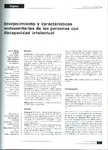Mostrar o rexistro simple do ítem
Envejecimiento y características sociosanitarias de las personas con discapacidad intelectual
| dc.contributor.author | Millán-Calenti, José Carlos | |
| dc.contributor.author | Seijas-Ramos, Sonia | |
| dc.contributor.author | Lodeiro, Susana | |
| dc.contributor.author | Mariana, Hebe | |
| dc.contributor.author | Quintana, Jorge | |
| dc.contributor.author | Meleiro, Luis | |
| dc.date.accessioned | 2015-04-08T10:29:06Z | |
| dc.date.available | 2015-04-08T10:29:06Z | |
| dc.date.issued | 2006 | |
| dc.identifier.citation | Millán-Calenti JC, Seijas S, Lodeiro S, Mariana H, Quintana J, Meleiro L. Envejecimiento y características sociosanitarias de las personas con discapacidad intelectual. Rev Multi Gerontol. 2006;16(2):79-86. | es_ES |
| dc.identifier.uri | http://hdl.handle.net/2183/14357 | |
| dc.description.abstract | [Resumen] Fundamentos: El incremento de la esperanza de vida de las personas con discapacidad intelectual, que representan un colectivo cada vez más numeroso, hace necesario conocer sus características y necesidades con respecto a otros grupos poblacionales que envejecen, objetivo que nos hemos trazado al realizar este trabajo. Métodos: Se realiza un estudio descriptivo sobre una muestra de 112 personas mayores de 35 años con discapacidad intelectual, que acuden a centros ocupacionales y que cumplen los criterios de inclusión establecidos. Resultados: eL 72,3% de los individuos residen en el hogar familiar. El 29,5% saben leer y escribir. De las causas conocidas de discapacidad, la congénita afecta al 55,4% de los casos. El 35,7% tiene disminuida la agudeza visual y el 34,8% la dentadura en mal estado. Un 20,5% tienen sobrepeso. Las enfermedades neuropsiquiátricas son las más prevalentes (52,7%), consumiendo fármacos el 49,1% de la muestra. Conclusiones: El grupo poblacional estudiado presenta una serie de alteraciones de salud y hábitos anómalos que hace necesario poner en marcha medidas adecuadas, tanto del área de la prevención como de la intervención a fin de lograr que alcancen edades avanzadas en una situación de salud que les permita afrontar en las mejores condiciones posibles la vejez. | es_ES |
| dc.description.abstract | [Abstract] Background: We aimed at determining both the particular features and needs of people with intellectual disability. In the light of the progressive aging showed by this population (and the subsequent growing number of individuals), it is mandatory to investigate its current situation and compare its scenario with the one showed by other aging groups. Methods: We present a descriptive survey, after studying 112 elderly people with intellectual disability, i.e., >35 years old. All of them were at occupational centres and fufilled the establishment inclusion criteria. Results: As much as 72,3% of the studied individuals lived with their families. Regarding education, 29,5% of them can read and write. Concerning the causes of their disability, congenital diseases explained a 55.4% of the cases. Visual ability was disminished in 35.7% of tha sample, badly preserved teeth were present at 34.8% of the individuals. In addition, 20.5% of them suffered overweight. Neuropsychiatric disorders were the most prevalent (52.7%) diseases. Almost half of the individuals (49.1%) conssumed some kind of prescription drug. Conclusions: The studied population showed certain health problems and anomalous habits. All this makes necessary to start a set of appopiate actions, not only regarding prevention, but also concerning intervention. The final goal is people with intellectual disability to become healthy elderly, i.e. to face aging under a better scenario. | es_ES |
| dc.language.iso | spa | es_ES |
| dc.publisher | Nexus | es_ES |
| dc.subject | Envejecimiento | es_ES |
| dc.subject | Discapacidad intelectual | es_ES |
| dc.subject | Características sociosanitarias | es_ES |
| dc.subject | Aging | es_ES |
| dc.subject | Intellectual disability | es_ES |
| dc.subject | Sociosanitary features | es_ES |
| dc.title | Envejecimiento y características sociosanitarias de las personas con discapacidad intelectual | es_ES |
| dc.type | info:eu-repo/semantics/article | es_ES |
| dc.rights.access | info:eu-repo/semantics/openAccess | es_ES |
Ficheiros no ítem
Este ítem aparece na(s) seguinte(s) colección(s)
-
GI-GIGG - Artigos [115]






